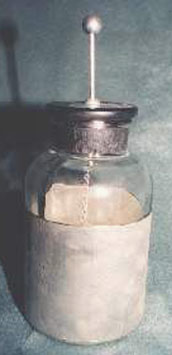Nollet Electrifies Royal Guard: Difference between revisions
No edit summary |
No edit summary |
||
| Line 1: | Line 1: | ||
[[Image:Leyden jar.jpg|thumb| | [[Image:Leyden jar.jpg|thumb|right|Leyden Jar]] | ||
In April 1746, Abbé Nollet transmitted the charge of a [[Leyden jar|Leyden jar]] through a chain of 180 Royal Guards in Paris. Soon afterwards he performed a grander experiment at a Carthusian convent, making a 5,400-foot circle monks all give "a sudden spring" simultaneously. | |||
Nollet was born in 1700 near Oise, France. While running a monastery, he became one of his generation’s best-known experts on electricity. He was a member of the Royal Society of London and later became the first professor of experimental physics at the University of Paris. In 1745, he publicized a theory of electricity proposing a continuous flow of competing fluids between charged bodies—the so-called two-fluid theory that “affluent” and “effluent” currents moved among bodies through “pores.” | Nollet was born in 1700 near Oise, France. While running a monastery, he became one of his generation’s best-known experts on electricity. He was a member of the Royal Society of London and later became the first professor of experimental physics at the University of Paris. In 1745, he publicized a theory of electricity proposing a continuous flow of competing fluids between charged bodies—the so-called two-fluid theory that “affluent” and “effluent” currents moved among bodies through “pores.” | ||
Revision as of 13:11, 28 April 2014
In April 1746, Abbé Nollet transmitted the charge of a Leyden jar through a chain of 180 Royal Guards in Paris. Soon afterwards he performed a grander experiment at a Carthusian convent, making a 5,400-foot circle monks all give "a sudden spring" simultaneously.
Nollet was born in 1700 near Oise, France. While running a monastery, he became one of his generation’s best-known experts on electricity. He was a member of the Royal Society of London and later became the first professor of experimental physics at the University of Paris. In 1745, he publicized a theory of electricity proposing a continuous flow of competing fluids between charged bodies—the so-called two-fluid theory that “affluent” and “effluent” currents moved among bodies through “pores.”
Nollet was an empiricist who thrilled audiences with spectacular tests of electricity. He impressed King Louis XV at Versailles by sending a discharge from a Leyden jar through a company of 180 soldiers as they held hands. All of the soldiers jumped up at the same time as the charge passed. Nollet did a similar experiment in Paris on 700 monks holding hands in a line.
Ironically, Nollet’s amazing experiments with the Leyden jar inspired other scientists to question his theories. In 1746, British physicist William Watson duplicated Nollet’s monk experiment, but proposed that the nearly instantaneous transfer of electricity could be better explained as the action of a single electrical ether that was neither created nor destroyed as it moved among the bodies. Soon after, Benjamin Franklin challenged Nollet’s arguments with the contention that electricity acted externally on bodies and operated through a single electrical fluid.
